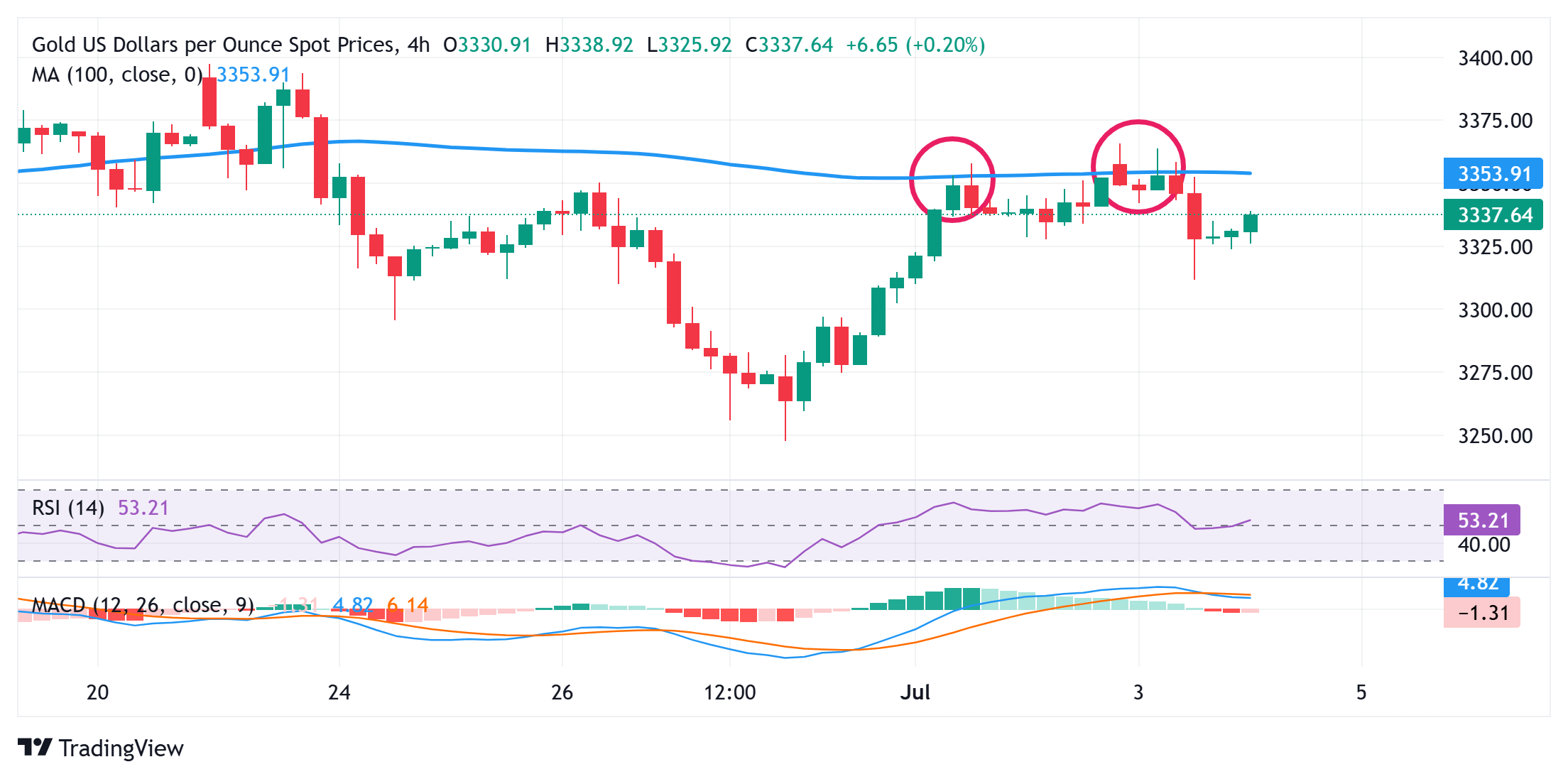
- Gold price regains positive traction and reverses a part of Thursday’s upbeat NFP-inspired losses.
- US fiscal concerns weigh on the USD and lend support to the commodity amid trade uncertainties.
- Holiday-thinned liquidity might hold back the XAU/USD traders from placing fresh directional bets.
Gold price (XAU/USD) maintains its bid tone through the first half of the European session on Friday, though it remains below a one-week high touched the previous day. The US Dollar (USD) struggles to capitalize on the upbeat US NFP-inspired rally on Thursday amid concerns that US President Donald Trump’s ‘One Big Beautiful Bill’ would worsen the country’s fiscal situation. This, along with persistent trade-related uncertainties, turns out to be a key factor underpinning demand for the safe-haven precious metal.
Meanwhile, traders dialled back expectations that the Federal Reserve (Fed) would cut interest rates in July following the release of a stronger-than-expected US jobs report. This, in turn, is seen as acting as a tailwind for the USD. Apart from this, a generally positive risk tone holds back the XAU/USD bulls from placing aggressive bets. Nevertheless, the Gold price remains on track to end in the green for the first time in three weeks. Moreover, the fundamental backdrop suggests that the path of least resistance for the commodity is to the upside.
Daily Digest Market Movers: Gold price sticks to gains as US fiscal concerns undermine USD
- The US Dollar touched a one-week high on Thursday after the US Bureau of Labor Statistics reported that Nonfarm Payrolls increased by 147,000 in June, beating forecasts of 111,000. Adding to this, the Unemployment Rate edged down to 4.1%, from 4.2% in May, and dashed hopes of an early interest rate cut by the Federal Reserve.
- Other details of the report showed that wage growth, as measured by the change in the Average Hourly Earnings, slowed to 0.2% in June from 0.4% previously and retreated to 3.7% from 3.8% in May. This helps to ease inflation concerns and keeps the door open for at least two 25 basis points rate reductions by the end of this year.
- US President Donald Trump’s tax-cut and spending bill cleared its final hurdle in Congress on Thursday. According to the nonpartisan Congressional Budget Office, the legislation will add $3.4 trillion to the nation’s debt. This could further worsen America’s long-term debt problems, which caps the USD and supports the Gold price.
- Meanwhile, Trump said that he plans to start sending letters informing trading partners of their tariff rates as soon as Friday, as negotiations to avoid higher US levies enter the final stretch. His comments come days before the July 9 deadline for steeper reciprocal tariffs and further act as a tailwind for the safe-haven precious metal.
- US markets will be closed on Friday in observance of Independence Day, warranting caution before placing aggressive bets around the XAU/USD amid the holiday-thinned liquidity. Nevertheless, the commodity remains on track to snap a two-week losing streak and the supportive fundamental backdrop favors bullish traders.
Gold price could accelerate the positive move once the 100-SMA on H4 is cleared decisively

From a technical perspective, this week’s repeated failures to build on the momentum beyond the 100-period Simple Moving Average (SMA) on the 4-hour chart warrant some caution for the XAU/USD bulls. The said barrier is currently pegged near the $3,352-3,355 area and should act as a key pivotal point. This is closely followed by the overnight swing high, around the $3,365-3,366 region, above which the Gold price could aim to reclaim the $3,400 round figure.
On the flip side, the $3,326-3,325 area now seems to protect the immediate downside ahead of the $3,311-3,310 region and the $3,300 round figure. A convincing break below the latter might shift the near-term bias in favor of bearish traders and make the Gold price vulnerable to accelerate the slide to the next relevant support near the $3,270 horizontal zone. The downward trajectory could extend further towards retesting the monthly swing low, around the $3,248-3,248 region.
US Dollar FAQs
The US Dollar (USD) is the official currency of the United States of America, and the ‘de facto’ currency of a significant number of other countries where it is found in circulation alongside local notes. It is the most heavily traded currency in the world, accounting for over 88% of all global foreign exchange turnover, or an average of $6.6 trillion in transactions per day, according to data from 2022. Following the second world war, the USD took over from the British Pound as the world’s reserve currency. For most of its history, the US Dollar was backed by Gold, until the Bretton Woods Agreement in 1971 when the Gold Standard went away.
The most important single factor impacting on the value of the US Dollar is monetary policy, which is shaped by the Federal Reserve (Fed). The Fed has two mandates: to achieve price stability (control inflation) and foster full employment. Its primary tool to achieve these two goals is by adjusting interest rates. When prices are rising too quickly and inflation is above the Fed’s 2% target, the Fed will raise rates, which helps the USD value. When inflation falls below 2% or the Unemployment Rate is too high, the Fed may lower interest rates, which weighs on the Greenback.
In extreme situations, the Federal Reserve can also print more Dollars and enact quantitative easing (QE). QE is the process by which the Fed substantially increases the flow of credit in a stuck financial system. It is a non-standard policy measure used when credit has dried up because banks will not lend to each other (out of the fear of counterparty default). It is a last resort when simply lowering interest rates is unlikely to achieve the necessary result. It was the Fed’s weapon of choice to combat the credit crunch that occurred during the Great Financial Crisis in 2008. It involves the Fed printing more Dollars and using them to buy US government bonds predominantly from financial institutions. QE usually leads to a weaker US Dollar.
Quantitative tightening (QT) is the reverse process whereby the Federal Reserve stops buying bonds from financial institutions and does not reinvest the principal from the bonds it holds maturing in new purchases. It is usually positive for the US Dollar.
Information on these pages contains forward-looking statements that involve risks and uncertainties. Markets and instruments profiled on this page are for informational purposes only and should not in any way come across as a recommendation to buy or sell in these assets. You should do your own thorough research before making any investment decisions. FXStreet does not in any way guarantee that this information is free from mistakes, errors, or material misstatements. It also does not guarantee that this information is of a timely nature. Investing in Open Markets involves a great deal of risk, including the loss of all or a portion of your investment, as well as emotional distress. All risks, losses and costs associated with investing, including total loss of principal, are your responsibility. The views and opinions expressed in this article are those of the authors and do not necessarily reflect the official policy or position of FXStreet nor its advertisers. The author will not be held responsible for information that is found at the end of links posted on this page.
If not otherwise explicitly mentioned in the body of the article, at the time of writing, the author has no position in any stock mentioned in this article and no business relationship with any company mentioned. The author has not received compensation for writing this article, other than from FXStreet.
FXStreet and the author do not provide personalized recommendations. The author makes no representations as to the accuracy, completeness, or suitability of this information. FXStreet and the author will not be liable for any errors, omissions or any losses, injuries or damages arising from this information and its display or use. Errors and omissions excepted.
The author and FXStreet are not registered investment advisors and nothing in this article is intended to be investment advice.








